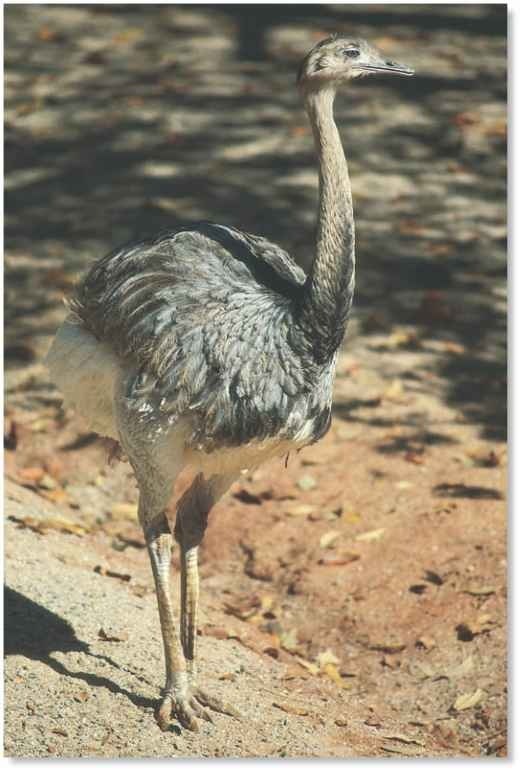ORDER
Struthioniformes
FAMILY
Rheidae
GENUS & SPECIES
KEY FEATURES
• Though flightless, the greater rhea is a swift runner and a good swimmer
• Heaviest New World bird, but it can almost disappear from view when it flattens its body on the ground
• Several females lay up to 30 eggs in one nest; a single male incubates them and takes care of the chicks after hatching
WHERE IN THE WORLD?
Found on the open plains in central and southern regions of South America, with main concentrations in Brazil, Uruguay, Paraguay, Bolivia and Argentina

Lifecycle
The greater rhea is highly sociable and lives in mixed groups of males, females and juveniles; males prepare nests and incubate the eggs, which is unusual among birds.
Habitat
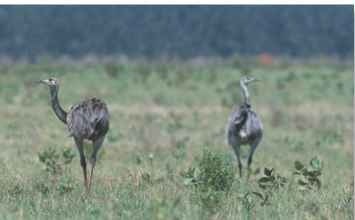
A Always alert
Two rheas look and listen for danger lurking in the savannah grasses.
The greater rhea resides in South America’s savannahs and in sparse woodlands, called chacos. It can also be found in Brazil’s campos regions, areas of dense grassland and scrub with scattered trees. In Argentina the rhea occurs at altitudes as high as 6,500′; it also frequents the edges of woods and feeds near farmland. The regions rheas inhabit have no distinct dry season, so food and water are plentiful year-round.
# Deeply rooted in South American culture, the rhea often appears in folklore as a theme to popular songs or through the use of feathers in some dances.
The rhea inflates its esophagus with swallowed air to increase the effectiveness of its calls.
Charles Darwin first noted the difference between the greater and lesser rhea while eating a cooked rhea leg; he saw a difference in size and bone structure.
The rhea sleeps sitting on its heels (tarsi) with its neck folded over to one side in an S-shaped curve.
Breeding
In their efforts to attract females, males compete with each other for the best territories. During the courtship display, the male puffs out the feathers along his neck and produces a booming call. This deep, resounding call sounds more like a large mammal’s roar than the sound a bird might make. The male copulates with several females, which then lay their eggs in a single nest prepared by the male. Unlike most bird species, the male rhea incubates the eggs, which can number up to about 30.The females completely abandon the eggs and go off to mate with other males. After 35-40 days, the chicks emerge with a down coat that’s marked with grayish and white stripes. Males keep chicks together through a series of whistles. Chicks stay with the male for about six months, then usually remain in small groups until they reach maturity at about age 2.
the mating game
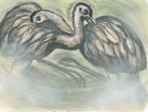
Competing for space…
Two male greater rheas circle each other during a biting match. Their necks become entwined as they fight over territory.
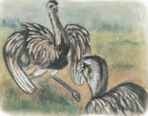
Victor makes his play…
After winning the battle, the victorious male puffs his feathers, hoping to attract a nearby female with his wing display.
Behavior
The rhea is active during the day and forages with a group of about 5-8 males, females and juveniles, though flocks can number over 50. Though gregarious, rheas remain a few feet apart from one another When threatened, the bird throws its head forward and hisses repeatedly. Equipped with excellent eyesight and hearing, the rheas can quickly identify approaching danger, including humans and birds of prey such as the caracara. Reaching speeds of over 35 mph, rheas can easily outrun most predators, but during a chase they often squat down suddenly among bushes and flatten their bodies on the ground to hide,eluding the pursuer I he bird is also a surprisingly good swimmer, with the ability to cross rivers.
Flightless feathers The fluffy wings are used for balance, not for flying.
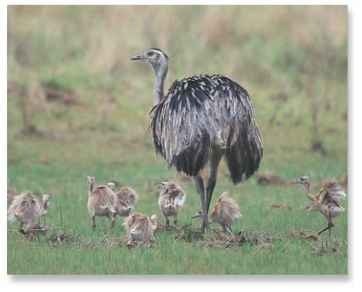
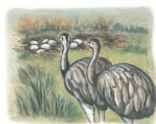
Step into my parlor…
After mating, the male leads the female to his nest, already filled with 10 eggs camouflaged with dried-out vegetation.
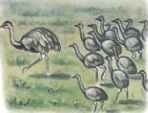
Male mama
After his brood hatches, the male leads a flock of young rheas to some large tussocks of grass in search of food.
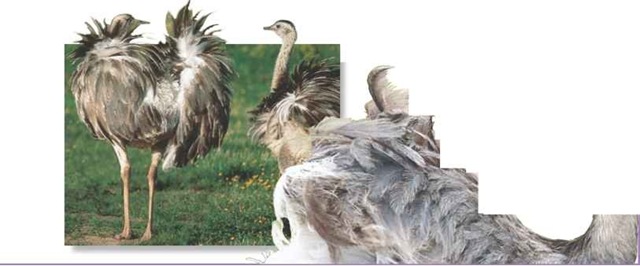

Conservation
Though not considered threatened, the greater rhea has suffered a decrease in its population, especially in Argentina, where it has been legally protected since 1981.The main threat facing the bird is the reduction of its habitat through the conversion of the plains to farmland or pastures for cattle to graze.The rhea also has been hunted for food and sport.The Convention for International Trade in Endangered Species (CITES) limits the export or import of rheas.
Food & feeding
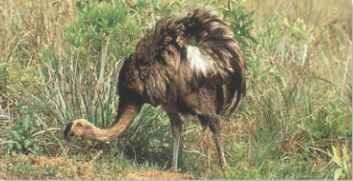
Persistent probe A rhea explores the savannah floor for food.
Rheas tend to wander while feeding with their flock. They often are seen with herds of pampas deer and even cattle and sheep. Rheas prefer clover, but
consume all kinds of plant matter; such as roots, fruits, seeds and leaves. The bird also eats insects and small vertebrates, such as lizards and frogs, and will catch flies and any small animals within 1^ reach. By eating burrlike seeds and thistle growths, the rhea actually aids sheep, since the prickly plant part often become tangled in the sheep’s wool.The rhea drinks little water, since most of its liquid requirements are satisfied by plants.
Profile
Greater Rhea
Sometimes called a South American ostrich, the flightless but long-legged greater rhea can reach speeds of more than 35 mph.
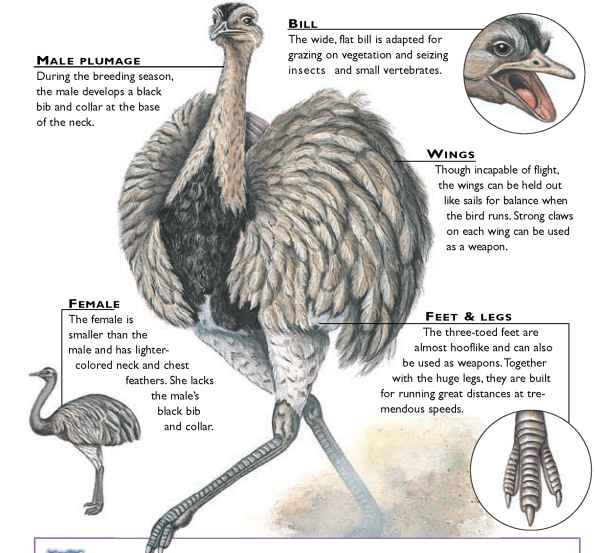
Creature comparisons
At 3.25′ tall, the lesser rhea (Pterocnemia pennata) is more compact than the greater rhea. This smaller species is quicker than the greater rhea, but has less stamina when it runs. The lesser rhea prefers the southerly regions of open scrub in South America, particularly Peru, Bolivia, Argentina and Chile. The bird also can be found in the puna (cold, dry mesa) of the Andean plateau at altitudes over 1 1,000′ high, an area the greater rhea doesn’t inhabit. Both rheas grow grayish plumage with smooth, soft feathers; however; the lesser rhea has varying numbers of white Greater rhea spots on its back, which allows the bird to blend with vegetation.


Lesser Rhea
| VITAL | |
| STATISTICS | |
| Weight | Up to 55 lbs. |
| Length | Up to 4.6′ |
| Wingspan | 5′ |
| Sexual Maturity | 2-3 years |
| Breeding Season | Varies according to region; lasts 3 months |
| Number of Eggs | 13-30 per nest |
| Incubation Period | 35-40 days |
| Brooding Period | 6 months |
| Typical Diet | Leaves, seeds, roots, fruits, insects and small vertebrates |
| Lifespan | 20 years in the wild; 40 years in captivity |
RELATED SPECIES
• The family Rheidae contains two genera, each with one species. The genus Rhea contains the greater rhea, while the genus Pterocnemia contains the lesser rhea. Relatives of the rhea include ostriches in the ‘ family Struthionidae, order I Struthioniformes. Rheas, cassowaries, emus and I kiwis also all belong to this order and are also called ratites; they lack the keel for the attachment of flight muscles.
